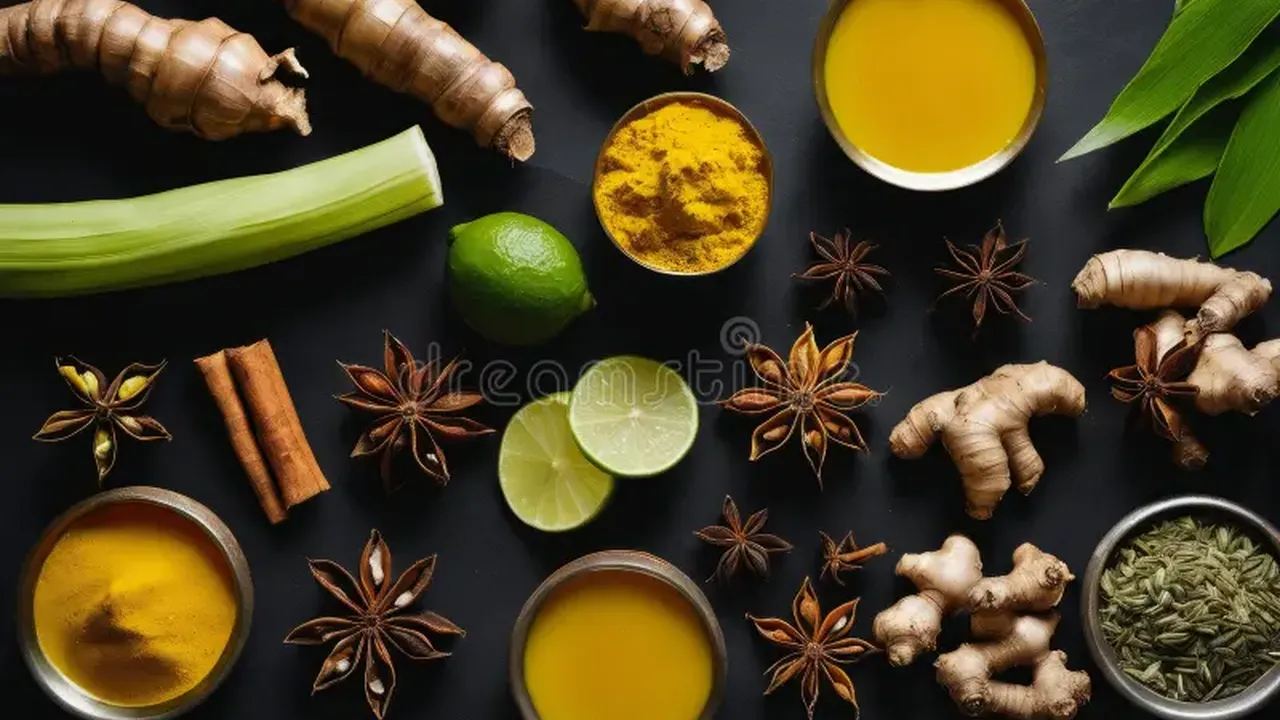Cooking with Thai herbs and spices: A flavorful journey

Unlocking the Secrets of Authentic Thai Cuisine with Fresh Herbs
Hey there, fellow food lovers! Ever wondered what makes Thai food so incredibly vibrant and delicious? It's all about the herbs and spices, baby! They're the secret weapon, the flavor bomb, the *je ne sais quoi* that elevates every dish. We're talking about a symphony of tastes – sweet, sour, salty, spicy, and savory – all dancing on your tongue. Forget bland, boring meals; we're diving headfirst into a world of aromatic adventures. This ain't your average culinary lesson; it's a passport to Thailand, one delicious bite at a time. We will explore essential herbs and spices in Thai cooking, providing tips on how to use them, where to buy them and some great recipe ideas.
Essential Thai Herbs for Your Kitchen Spice Rack: Aromatic Delights
Let's start with the all-stars, the MVPs of the Thai herb world. These are the ingredients you absolutely *need* to have on hand if you're serious about recreating authentic Thai flavors at home.
- Lemongrass (ตะไคร้ – Takrai): This citrusy stalk is a workhorse. Bruise it and add it to soups and curries for a bright, lemony aroma. You can also finely chop it for stir-fries. Look for firm, pale green stalks.
- Galangal (ข่า – Kha): Often confused with ginger, galangal has a more peppery, citrusy, and earthy flavor. It's essential in soups like Tom Yum and Tom Kha Gai. Choose firm rhizomes with a smooth, unblemished skin.
- Ginger (ขิง – Khing): A familiar face, but Thai ginger has a slightly sharper, more pungent flavor than its Western counterpart. Grate it, slice it, or pound it into pastes.
- Thai Basil (โหระพา – Horapha): With its anise-like flavor, Thai basil is a must-have for curries, stir-fries, and noodle dishes like Pad See Ew. It's more robust than Italian basil and can withstand higher heat.
- Holy Basil (กะเพรา – Kraphao): The star of Pad Krapow (holy basil stir-fry), this basil has a peppery, slightly spicy flavor. It's not easily substituted, so seek it out!
- Kaffir Lime Leaves (ใบมะกรูด – Bai Makrut): These fragrant leaves add a distinctive citrusy aroma to curries and soups. Tear them to release their oils. You can also use the zest of the kaffir lime fruit.
- Cilantro/Coriander (ผักชี – Phak Chi): Both the leaves and roots are used in Thai cooking. The leaves are a common garnish, while the roots add depth of flavor to curry pastes and soups.
- Mint (สะระแหน่ – Saranae): Used in salads, spring rolls and some curries, adding a fresh and cooling element.
Spicy Sensations: Exploring Thai Chili Peppers and Spice Blends
Thai food wouldn't be Thai food without a kick! Chili peppers are essential, and the variety is astounding. Here's a quick rundown:
- Bird's Eye Chili (พริกขี้หนู – Prik Kee Nu): Small but mighty! These are seriously spicy, so use them sparingly.
- Jinda Chili (พริกจินดา – Prik Jinda): A medium-heat chili commonly used in stir-fries and curries.
- Dried Chili Peppers (พริกแห้ง – Prik Haeng): Used to add smoky heat to curry pastes and sauces. Rehydrate them before using.
Beyond individual chilies, spice blends like curry pastes are fundamental. Red curry paste, green curry paste, and yellow curry paste each have their unique flavor profiles, thanks to a blend of chilies, herbs, and spices. Making your own is rewarding, but high-quality store-bought pastes are a convenient option.
Sourcing and Storing Thai Herbs and Spices for Maximum Flavor and Freshness
Where can you find these exotic ingredients? Your best bet is an Asian grocery store. They'll have the freshest herbs and the widest selection of spices. Farmers' markets are another good option, especially if you live in an area with a large Southeast Asian community. Online retailers are also a viable option, especially for dried spices and curry pastes.
When buying fresh herbs, look for vibrant green leaves and firm stalks. Avoid anything that looks wilted or discolored. Store fresh herbs in the refrigerator, wrapped in a damp paper towel inside a plastic bag. Dried spices should be stored in airtight containers in a cool, dark place. They'll lose their potency over time, so it's best to use them within a year.
Using Thai Herbs and Spices: Tips and Techniques for Authentic Flavor
Now for the fun part: putting these ingredients to use! Here are a few tips to keep in mind:
- Don't be afraid to experiment: Thai cooking is all about balance, so adjust the flavors to your liking.
- Start small: Especially with chilies! You can always add more, but you can't take it away.
- Bruise herbs to release their flavors: Gently crush lemongrass, galangal, and kaffir lime leaves before adding them to soups and curries.
- Use fresh ingredients whenever possible: The flavor difference is significant.
- Toast spices to enhance their aroma: Dry-toast cumin, coriander, and other spices in a skillet before grinding them for curry pastes.
Thai Herb and Spice Product Recommendations: Elevating Your Culinary Creations
Let's talk specifics. Here are some product recommendations to help you get started:
Curry Pastes: Ready-Made Flavor Bases
Mae Ploy Curry Pastes: These are widely considered the gold standard for store-bought curry pastes. They're authentic, flavorful, and readily available. Usage: Use them as a base for curries, adding coconut milk, vegetables, and protein. Comparison: Mae Ploy is generally considered higher quality and more authentic than other widely available brands like Thai Kitchen. Price: ~$3-5 per container.
Fish Sauce: The Umami Bomb
Red Boat Fish Sauce: Made from only two ingredients – black anchovies and sea salt – Red Boat is known for its clean, complex flavor. Usage: Use it sparingly to add depth and umami to stir-fries, soups, and sauces. Comparison: Cheaper fish sauces often contain additives and have a harsher flavor. Red Boat is more expensive but worth the investment. Price: ~$15-20 per bottle.
Coconut Milk: Creamy Goodness
Aroy-D Coconut Milk: This brand is known for its high fat content, resulting in a rich and creamy coconut milk. Usage: Essential for curries, desserts, and drinks. Comparison: Lower-fat coconut milks can be watery and lack flavor. Aroy-D provides the best texture and taste. Price: ~$2-3 per can.
Thai Chili Oil: A Fiery Finishing Touch
Lao Gan Ma Chili Crisp: While not strictly Thai, this chili oil is incredibly versatile and adds a delicious kick to any dish. Usage: Drizzle it over noodles, stir-fries, or even eggs. Comparison: This is a great option if you want a chili oil with some texture and crunch. Some Thai chili oils are just oil and chilies. Price: ~$5-7 per jar.
Recipe Inspiration: Delicious Dishes Featuring Thai Herbs and Spices
Ready to get cooking? Here are a few recipe ideas to get your creative juices flowing:
- Tom Yum Soup: A classic hot and sour soup featuring lemongrass, galangal, kaffir lime leaves, and chilies.
- Green Curry: A creamy and aromatic curry made with green curry paste, coconut milk, bamboo shoots, and your choice of protein.
- Pad Thai: A stir-fried noodle dish with shrimp, tofu, peanuts, and a tangy tamarind sauce.
- Pad Krapow: A spicy stir-fry with holy basil, ground meat, and chilies. Served over rice with a fried egg.
- Mango Sticky Rice: A sweet and creamy dessert made with sticky rice, coconut milk, and fresh mango.
Thai Cooking: A Journey of Flavor and Discovery
So there you have it – a deep dive into the wonderful world of Thai herbs and spices. Get out there, experiment, and have fun! Don't be afraid to make mistakes; that's how you learn. Happy cooking!
:max_bytes(150000):strip_icc()/277019-baked-pork-chops-with-cream-of-mushroom-soup-DDMFS-beauty-4x3-BG-7505-5762b731cf30447d9cbbbbbf387beafa.jpg)






